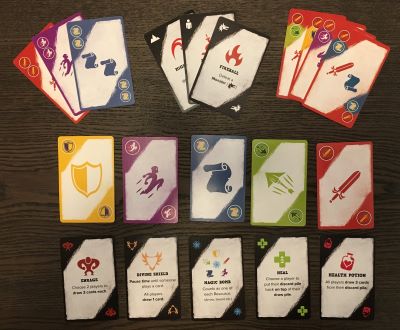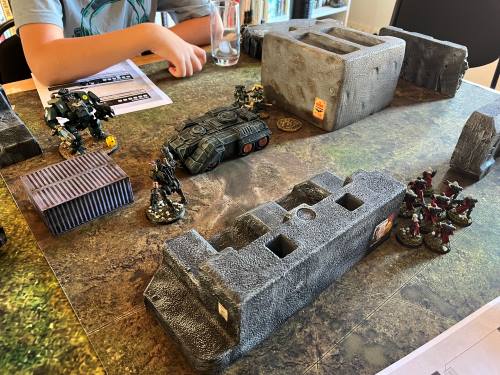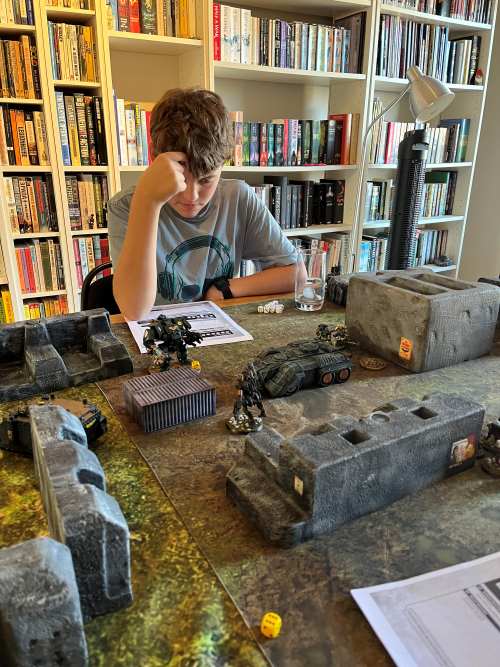If you’re looking for a game that combines frantic fun, teamwork, and the pressure of time, 5-Minute Dungeon is exactly what you need. This cooperative card game challenges players to battle through dungeons by defeating monsters, overcoming obstacles, and taking down powerful bosses—all in just five minutes.
We bought this as a Christmas present for the family a couple of years ago and fell in love with it! This gem of a game creates tension and puts the players under stress. To win, players must communicate quickly, think on their feet, and work together as a cohesive unit.
What Is 5-Minute Dungeon?
In 5-Minute Dungeon, players take on the role of a unique hero, each with their own special abilities. Working together, they then clear a series of dungeon levels home to a series of increasingly difficult boss monsters. Every dungeon is filled with challenges such as monsters, traps, and bosses, which must be dealt with by playing matching action cards from the players’ hands. The catch? You only have five minutes to clear each dungeon level.
The game requires fast communication and decision-making because there’s no time for long debates or hesitation. Each player contributes their unique deck of cards—swords, shields, arrows, scrolls, and more—and must play the right cards at the right time to survive. If you hesitate or fail to coordinate, you risk running out of time or resources, and the dungeon will defeat your team.
Teamwork Under Time Pressure
One of the standout aspects of 5-Minute Dungeon is the intense, ticking-clock urgency. This forces players to communicate clearly and act quickly. There’s no space for egos or excessive planning. Every player needs to understand their role and support others immediately. That urgency enhances teamwork in ways that slower-paced games might not, making it an ideal exercise for teams that need to learn how to collaborate efficiently under pressure.
This dynamic can translate directly into real-life team scenarios. In a high-pressure work environment, quick decision-making and seamless communication are vital. By playing 5-Minute Dungeon, team members get a taste of this experience in a low-stakes, fun environment. They’ll discover each other’s strengths and weaknesses in real time, learning how to balance leadership, delegation, and collaboration—all while under the clock.

How 5-Minute Dungeon Can Bring Teams Closer
While the time pressure forces rapid action, it’s the cooperation that brings players closer. The need for constant communication creates bonds between team members as they learn to trust each other’s judgment and skills. Each successful dungeon completed is a shared victory, reinforcing the idea that teams work best when they collaborate smoothly.
By playing 5-Minute Dungeon, teams practice how to adjust to different situations and adapt to various team members’ play styles. Whether it’s knowing when to use your special ability or when to sacrifice your cards to help someone else, the game demands a constant balancing act of individual and team needs.
Leadership in 5-Minute Dungeon
Now, imagine incorporating 5-Minute Dungeon into leadership training or team development. What if every time the game is played, a new leader is assigned? Each person would have a chance to practice leadership in a safe, playful environment. The leader could be responsible for rallying the team, calling the shots, and making quick strategic decisions under pressure. This rotating leadership format could help participants explore different leadership styles and approaches, building confidence in those new to leadership and offering reflection opportunities for more seasoned leaders.
Moreover, leaders would experience the importance of effective communication and see firsthand how their guidance impacts the team’s performance under stress. This practice would directly translate to real-world team dynamics, where leadership often means managing pressure while still keeping the team focused and aligned.
Bringing Levity to Leadership and Team Development
Incorporating games like 5-Minute Dungeon into leadership and team development sessions might sound unorthodox, but it brings a much-needed levity to the process. Traditional leadership training or team-building exercises can sometimes feel formal, and while they offer valuable lessons, the serious tone may not always foster the team closeness you’re looking for. A game-based approach shakes things up, allowing teams to bond over laughter, creativity, and shared experiences.
Mixing up teams every session and assigning different leaders will also help participants practice adapting to new roles and personalities. Each session becomes a new challenge, with new opportunities to lead, collaborate, and improve team cohesion. Plus, having fun together lowers stress, builds trust, and keeps the atmosphere light even while learning important teamwork and leadership skills.
Final Thoughts
5-Minute Dungeon isn’t just a fun card game—it’s a fast-paced exercise in communication, cooperation, and leadership. Its time constraints force teams to work quickly and efficiently, while the cooperative nature encourages team bonding. By using games like this in leadership training, you can offer a break from the typical learning format while still fostering essential skills such as collaboration, problem-solving, and decision-making under pressure. The blend of play and learning could be just what your team needs to level up their teamwork—and have fun doing it.



